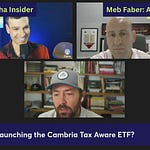Folks new to direct indexing usually haven’t considered portfolio ossification.
They may understand a mutual fund has a lot of embedded gains (caution ⚠️), but when tax-loss harvesting is front-and-center in portfolio implementation - as is the case with direct indexing - it’s worth understanding how cost basis falls following loss harvesting, as the portfolio continues to appreciate.
For folks taking advantage of step-up in basis, the spread between portfolio cost basis and fair market value is less important than the cost of managing tracking error.
In other words, as the portfolio realizes capital gains to rebalance (I sometimes call this the “self-inflicted wound of direct indexing” since equity ETFs using in-kind redemption usually bear no such cost to rebalance), ossification usually means the portfolio has fewer losses to offset those gains.





